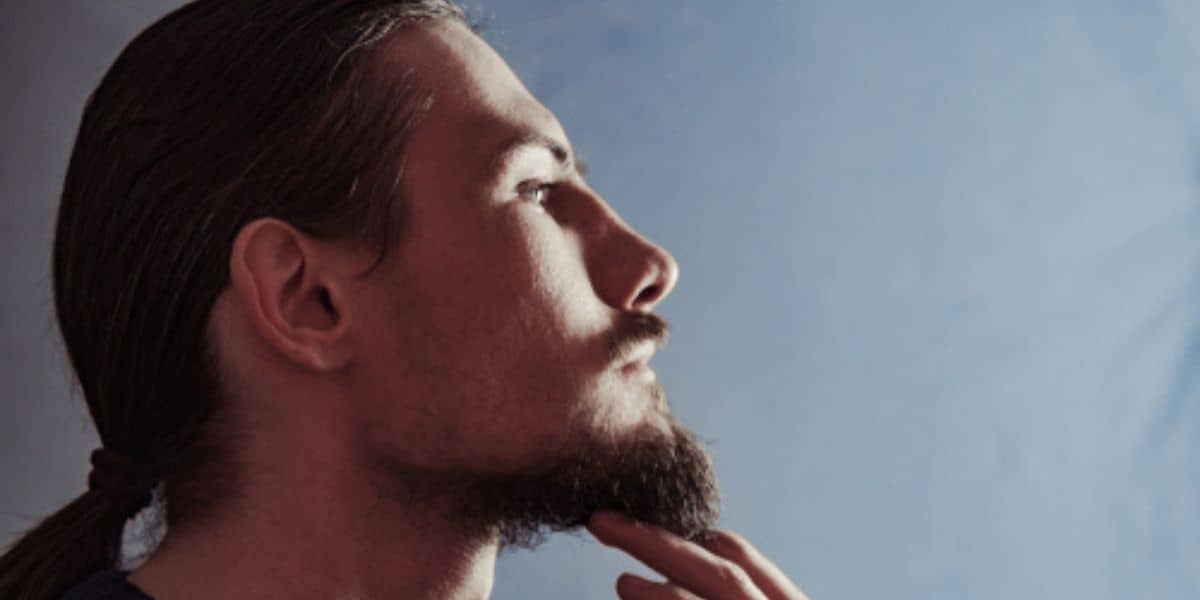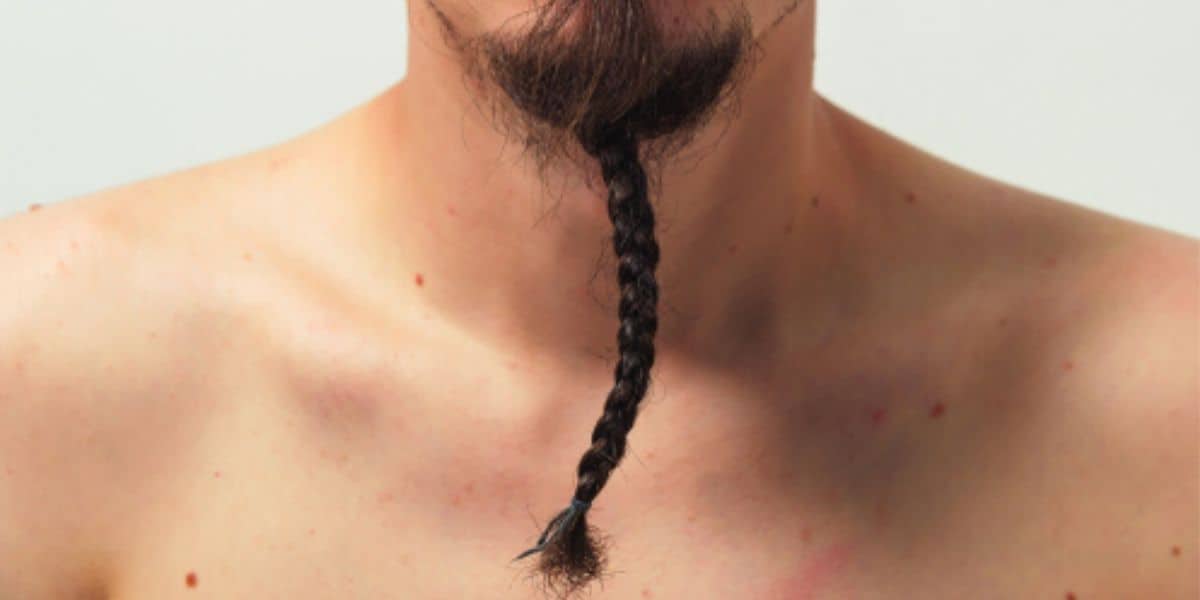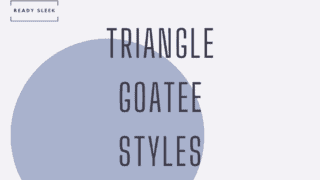The pointed goatee can take on many forms. Some short, some long, some wide, and some narrow. It can differ in texture, in depth, in tidiness, and more.
But the concept behind it and the manner in which it is achieved is universal. That’s what we’ll be discussing here.
The “point” of a goatee refers to the point at which the sides meet at the bottom. In other words, the tip of the goatee. Pointed beards have been popular for years, with the Ducktail and the French Fork leading the way in this arena.
But the pointed goatee is a unique beast that may be difficult to tame, but a worthy objective indeed. It brings with it all of the benefits and difficulties of a goatee. If you aren’t familiar with them, check out my other goatee articles as well.
Trimming it may seem as simple as sculpting a V-shaped beard, and in many ways that’s correct. But there’s a little bit more to it. Sculpting it so that the sides meet in a natural and gentle fashion is the key to succeeding with a pointed goatee.
We’ll be going on to teach you exactly how to achieve that. But first, let’s go through some phenomenal pointed goatees you can copy if you wish to.
5 Great Pointed Goatee Styles
Remember, a goatee is any style that consists of hair on the chin but not on the cheeks. The style may include a mustache – in fact, many modern definitions of a “goatee” do include a mustache.
But the underlying principle is generally that there can’t be any hair on the cheeks. Having said that, there are certainly goatees where the cheek hair is simply very short relative to the chin beard. For example, the the goatee with stubble.
You’ll also see a goatee style where the sides fade nicely into the goatee – that one makes an appearance on this list as well. Sorry for ruining the surprise. Let’s get to it.
1. Disconnected Mustache And Pointed Goatee
As the name would suggest, this style consists of a mustache as well as a chin beard. The chin beard is beautifully sculpted into a pointy goatee. A glorious V-shape that certainly takes center stage.
The mustache, however, is distinct from the chin beard. The two are not connected. It’s similar to a Van Dyke in that respect, but I’m generally hesitant to label a style a Van Dyke without a Handlebar mustache. This is a variant you could adopt if you wish to, however.
The style is ideal for men whose mustache and chin beard don’t connect – believe me, there are many of them out there.
2. Pointed And Extended Goatee
This is simply an extended goatee with the sides ultimately leading to a V-shaped point. Once again, although it’s called a “V-shape”, the sides shouldn’t be dead straight and meeting at an acute angle.
The sides should be gently cupped, with the goatee tip gentle and slightly rounded. This is far more attractive and less jarring to look at. Try to achieve this with whatever pointed goatee style you go for.
An extended goatee is one where the sides tail backward partially along the jawline. Not far back enough to be considered a chinstrap. Just a little bit.
It’s a wonderful way of providing some definition and contouring to the jawline. Although it comes with a slightly increased trimming requirement, the subtle change can make quite a significant difference.
3. Faded To A Point
This is what I was referring to when I said you could have cheek hair that faded into the goatee. The effect can be subtle, or it can be quite profound.

Either way, it usually works very nicely and does well to draw attention.
The cheek hair is faded from long to short as you go outward from the sides of the chin beard (goatee) to the cheek line. The longer the goatee, the more pronounced the effect.
As you’d expect, the trimming and maintenance requirements are greater with this style. Having to fade a beard from long to short isn’t difficult, but it does take time. The easiest way to do it would be to use a pair of clippers.
You may be wondering why this style dares to label itself a goatee when there’s clearly hair on the cheeks. Well, that’s a very valid argument. Trust me, you’ll get different opinions from different people.
Some people may even say that a full beard can be called a “goatee”. The “goatee” aspect simply refers to the fact that the chin beard is considerably longer than the sides.
Definitions aren’t usually very important. It’s more important to just have a general, broad understanding of the underlying concepts so you can use them to tailor your own, unique style.
4. Long Traditional Goatee
This one may not be for everyone as it can look quite dated – particularly when not groomed properly. But it’s worth knowing about.
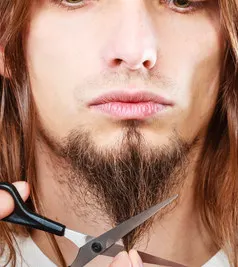
A traditional goatee is one where there is hair on the chin and nowhere else. Of course, there won’t be any hair on the cheeks. The twist, however, is that there can’t be a mustache either.
This is a goatee in its purest form. It was particularly popular around the ‘40s and ‘50s when soul patches and goatees took hold of the California art scene and didn’t let go for quite some time.
The traditional goatee could be a little Chin Puff. However, it could also be a slightly longer, more pointed tuft. This is what we’re talking about here.
It’s fairly simple to maintain – after all, how hard could it be to maintain a single tuft?
But it’s important to maintain and nurture that tuft to prevent it from growing unruly. Brush it, comb it, oil it. Don’t take it for granted. Trim the sides to keep the point pronounced, yet natural.
5. The Braided Goatee
I wanted to slip this one in here because it’s just so much fun. I won’t delve too deep into it, however, because I know most of you won’t ever try it.
However, if you do have a particularly long chin beard and want to try something new, give it a go. Even if it’s in the darkest corner of your own home with the curtains drawn and every door triple-locked, try it out.
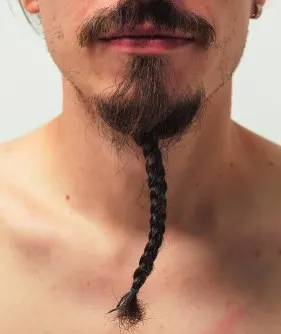
If you want to know how to do it, here’s an article teaching you exactly how to braid a goatee.
Essentially, the long chin beard is knotted into a braid. It’s a throwback to a Nordic era, where braided, bearded Vikings ruled the seas.
So much fun.
How To Grow, Trim And Shape A Pointed Goatee
You’ve seen some examples of this glorious style. It’s time to learn how to get one for yourself. Remember, a pointed goatee can take many forms.
You may want a small, pointed tuft. Or, you may want a long, luscious, Ducktail-style V-shaped beast.
It doesn’t really matter. The two core principles are:
- Trim the goatee sides into a gentle V-shape meeting at a slightly rounded tip.
- Choose what you want to do with the cheeks – sides, stubble, or faded?
1. Grow out the chin beard
In order to sculpt it into a point, you’ll want to give it enough time to reach your desired length. This is, of course, an entirely personal decision.
You’ll have to put up with it looking a little untidy until it’s time to trim it down. Regularly brushing it should not only train it to grow downward, but it’ll also keep it neat and flat.
A beard doesn’t grow into a point. This is because the chin beard grows outward and meets the cheek hair that grows downward. It usually grows bushy and broad.
Your job is to sculpt it into a narrower, more V-shaped beard.
2. Trim the cheeks down
Trimming day will come round sooner than you think. Your chin beard is sufficiently long enough to form that beautiful pointy goatee.
Now is a good time to decide what to do with the cheek hair. If you’re looking to keep the chin beard and mustache and nothing else, your decision is simple.
Using the naked blade of your electric clipper or trimmer, trim the cheek hair down completely. This will trim it down to very short stubble – usually around 0.4mm.
Alternatively, if you want a bit of cheek hair but not much, set your device to an appropriate length and trim your cheeks down to that length instead. This could be anything – 4mm, 8mm, etc. It doesn’t matter. All that matters is that the cheek hair is considerably and noticeably shorter than your goatee (the chin beard and mustache).
You’ll want to ensure you don’t trim into the shape of the goatee itself. Visualize the sides of what your goatee will become before you trim its outline.
The sides of the goatee should be considered an extension of your mustache. Simply follow the curve of your mustache downward and you will get a nice, natural outward curve to your goatee sides.
This will ensure you don’t make the sides too vertical and the goatee too narrow as a result.
If you’re looking for a more complex or nuanced style, you can fade the cheeks as you go from the goatee sides outward to the cheek line. To do this, you’ll want to gradually shorten the length as you go outward.
Splitting the cheek hair into thirds and dropping a clipper grade (or smaller increments if your hair is particularly short) as you move up toward the cheek line usually does the trick.
Because it’s more complex, watching your barber do it the first couple of times is probably a good idea. After this, you can venture out and do it on your own.
3. Trim the chin beard into a V-shape
This is where you start to sharpen up the sides of the long goatee into a V-shape. The most efficient way to do it would be to use a beard comb.
Use a beard comb to hold the sides of the chin beard in a “V-shape”. This will hold the hair in place as you trim. You can either trim over the comb using a pair of scissors, or the naked blade of your trimmer or clipper.
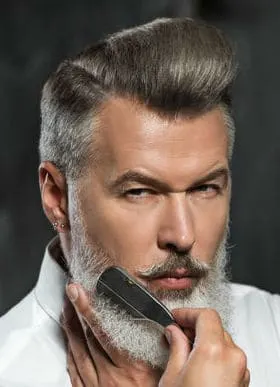
The good thing about using a comb is that you can easily adjust how much length you want to take off from the sides of the chin beard.
Plus, you can also frequently comb the beard downward to get an up to date idea of what the beard looks like.
The aim is to make the sides more angular so that they look like they meet at a point. You may only need to take a very small amount of length off from the sides.
If you don’t want to use a comb, try doing the same thing without a comb. Be very careful not to trim too much into the bulk of the chin beard. Go nice and slow.
You’ll notice that the sides start to look like they meet at a point, as opposed to simply looking like a broad, square, chin beard.
How angular you want to keep this point is up to you. Try not to make it too pointy, however, as this can look unusual. Give the tip a slightly rounded edge – using a pair of scissors is a good way to achieve this.
This last step is optional, as it probably looks pretty good by now. But if you’re looking for perfection, you’ll want to clean up any stray hairs sticking out. You’ll be able to see these if you look from the side.
Using the naked blade of your clipper or trimmer, gently brush the blade along the very surface of your goatee. You aren’t trimming any of the bulk of the beard here. You are simply trying to catch the tips of the beard hairs that stick out. Be very, very, gentle.
Using this technique going backward from the tip of the chin beard toward the Adam’s apple should provide the finishing touch. It really neatens up the pointed goatee.
4. Neaten up the mustache
Mustache trimming is an entirely different topic. Here are articles on how to trim a mustache with scissors and how to trim it with clippers if you’re interested.
But even if you aren’t looking for an in-depth tutorial, you’ll want to neaten it up at this point. You may want to remove some of the bulk of the mustache itself.
But the only truly essential step to take at this point would be to trim the stray, scraggly hairs that creep over the upper lip toward the inside of the mouth. This hair needs to go.
You can either choose to do this with scissors, or with trimmers. Trim a nice, natural, horizontal line immediately above the upper lip so that no hair creeps over it.
Keep a neutral expression as you do it, maybe with a slight smile. Look straight ahead at this point. Afterward, tilt your head downward to spot any you may have missed.
5. Define the neckline
Neck stubble must go! It just never looks good. When your goatee is trimmed into a V-shape there’s more neck on show. Because of this, it’s even more important to carefully define a proper neckline and remove any neck stubble.
A good neckline usually lies approximately two finger-widths above the Adam’s Apple. Allow it to gently follow the angle of your jawline upward on either side. Although every man’s “perfect neckline” will vary, just try to make sure it isn’t too high.
Trim down everything beneath your neckline with the naked blade of your trimmer or clipper. You’ll be shaving over this area as well in the next step.
6. Shave for perfection
The main area this is crucial for is the neck, as we’ve established. Shave the area of the neck beneath the neckline. You could use a manual razor, a straight razor, or a safety razor. It doesn’t matter – just be sure to keep the skin moist to reduce irritation.
Shaving gel or oil is important. You could even use an electric shaver, in which case you wouldn’t need gel. Your budget will play a role here.
You’ll also want to shave the cheeks. If you’ve decided to keep stubble or short cheek hair, simply shave any stray hair above the cheek line.
If you’ve decided to remove all of the cheek hair, you’ll get a much slicker and smoother outcome if you shave over the area as well.
7. Apply some beard oil
Beard oil is arguably the most masculine product ever concocted. Applying a few drops into your pointed goatee after you’ve rinsed it out and towel-dried it will make you feel like a Nordic warrior.
It’s thoroughly moisturizing, as well as nourishing.
To accentuate the pointedness of the goatee, a little beard of beard balm or beard balm will go a long way. They’re great for flattening out stray hairs and keeping the V-shape – well, V-shaped, for the entire day.
8. Moisturize
As always, be sure to moisturize well after a heavy-duty trimming and shaving session. Your skin is likely to be mighty irritated by now, so soothe it well with a gentle moisturizing cream.
Conclusion
There you have it. You’ve learned what it is, as well as how to achieve it. It isn’t difficult, as you’ve probably realized.
Although there are many different styles you could choose from, the underlying principles and concepts remain the same.
Keep it neat, keep it symmetrical, keep it natural. Don’t go overboard – make small trims when you aren’t sure. The problem with longer beard styles is that making mistakes are more costly. Go nice and slow the first few times you do this.
Watching a professional do it the first few times is usually a wise option. However, it’s perfectly acceptable to simply experiment on your own until you get it right as well.
Experimentation is part of the fun.
Ready Sleek founder. Obsessed with casual style and the minimalist approach to building a highly functional wardrobe. Also a fan of classic, vintage hairstyles.

